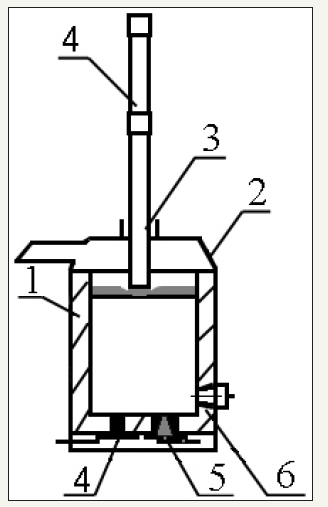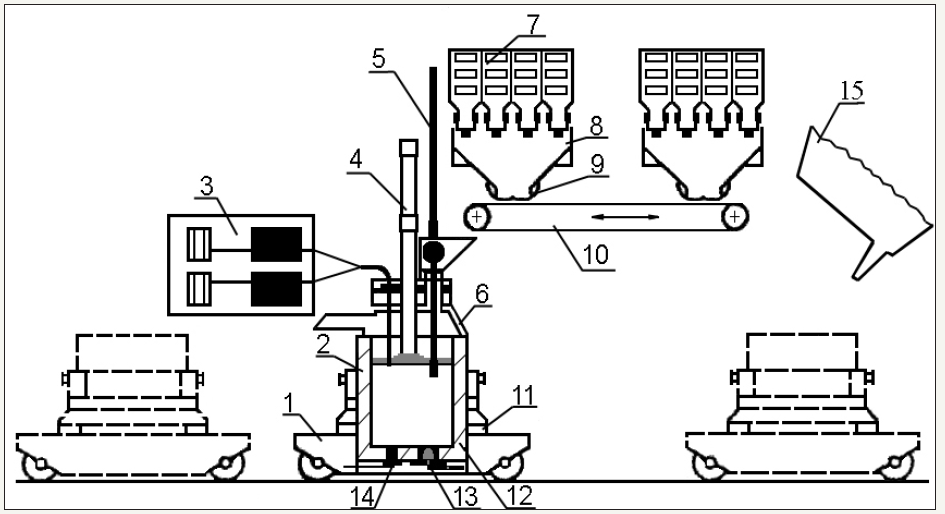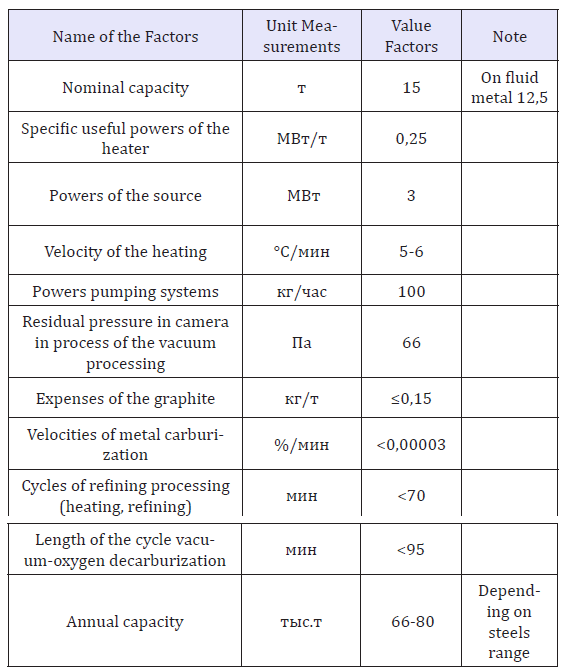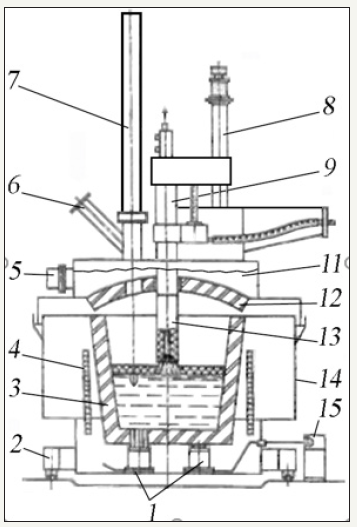- Submissions

Full Text
Evolutions in Mechanical Engineering
Development and Studies of Secondary Steelmaking Units with Electric Heating of the Metal by Direct Current Arc
Protasov AV1*, Sivak BA and Bershitzky IM
Department of SSC VNII Met mash, Russia
*Corresponding author:Protasov AV, Department of SSC, VNIIMETMASH, Russia
Submission: December 13, 2018;Published: January 18, 2019

ISSN: 2640-9690 Volume2 Issue2
Abstract
Different aspects of technologies and equipment for secondary refining of liquid steel in the ladles with bath heating by DC arc and various disposal of electrodes are examined. The principal shemes and calculated characteristics of some projects of pilot aggregates ladle-furnace and vacuum arc degassing, designed by three institutes: VNIIMETMASH, TsNIICHERMET and VNIIETO are given. Technico-economic and ecological advantages of metal heating by DC or plasma arc and results of executed experiments give the foundation for continue of works in this direction.
Keywords:Ladle; Furnace; Bath; Electric heating; Current; Arc; Grafite electrod; Steering; Carburization; Refining; Degassing
Introduction
Liquid steel processing; both under atmospheric pressure; and at vacuum with electric heating considerably improves characteristics of melting unit; continuous casting machines and steel-melting shop as a whole. The exception of necessity in overheat of melted steel provides the reduction of melting cycle; reduction of the consumption electric powers; electrode and lining in arc furnace; possibility of the narrow warm-up interval maintain at casting promotes increasing casting series and billet drawing velocity.
At present metallurgical enterprises in the world uses more than 500 ladle-furnaces and VAD (vacuum arc degassing -vacuumarc degassing); with heating of the metal; realized; most often; by three-phase arc with three electrodes; disposable in roof of the ladle; similarly arc furnace of alternating current. However condition and prospects of their development greatly differ: if creation unit ladlefurnace lasts by the tempestuous rate; creation of new combined unit vacuum degassing and heating is stopped.
The main defect all combined unit are a complexity of construction; d; conditioned by need to capsulation three rolling electrodes; and low capacity; connected with consequent metal undertaking at one stand of the row operation. So, in world practical vacuumators VAD are used mainly at production large ingots from high-quality steels; including associations several melts. The defect of the heating by alternating current arc are: fluctuations of the voltage in network; high level of the noise; carburization of melt. So though in suppressing majority of ladle-furnaces used for heating alternating current; search work on prospecting new methods of heating be plasma or DC arc are conducted already long time.
They are more ecological; energy efficient; technologically flexible. By that an experience of the plasma and direct current furnaces is used. Using of the direct current provides the reception of the row advantage: reduction of melt carburization; absence of the hindrances in external network; more stable combustion of the arc; reduction of the electrode consumption; separations of the smoke and noise; possibility to organize conduction electromagnetic stirring of bath under direct current flow. Presence of only one central electrode (the cathode) allows to increase distance between the arc and lining of ladle wall and; hereunder; greatly raise lining durability.
The Institute of ferrometallurgy (Bulgaria) and company ABB designed variant of the electric heating of the metal with three upper electrodes (Figure 1); [1]. The unit includes central graphite cathode and two symmetrical located graphite anodes submerged in slag. Between cathode and anodes through slag two circuits of the direct current arise. The electric arc between cathode and fluid metal is located vertically. In contrast with traditional unit ladlefurnace distance from arc and wall of the ladle less and equally in all directions that favorably influents on refractory lining. The first unit of such type by 15t are put in exploitation in Bulgaria in 1986. Experience of usages have confirmed efficiency of use such unit using; first of all; for production of the metal with specifically low Sulphur contents.
Figure 1:Principle scheme of the processing at ladle-furnace of DC heating with upper location of three electrodes.

The unit ladle-furnace of such type for 160t ladle has installed in converter shop 1 at Novolipetzk metallurgical combinat. The power source provides the useful power 16MVT; maximum amperage 60kA; it is confirmed design velocity of the heating of the metal 3;5 °С/min) [ 2]. The principle defect of the similar scheme of the heating are: observable carburization of melt (before 0;02%); inadmissible when processing of low carbon steels; and absence of the possibility of the conduction electromagnet stirring creation in whole volume of the ladle. From the end 1980-h years CNIICHERMET im. I.P. Bardina; VNIIETO and NIIMETMASHim A.I. CELIKOVA conducted work on creation unit complex processing with direct current without such problems with top and bottom electrodes; working under atmospheric pressure (AKOS) or in condition of the vacuum (AKVOS).
The row of the search work on determination of the optimum scheme of the bath heating by plazma/DC was executed at the base of plazma and DC furnaces exploitation. The designed variants of ladle-furnaces of the direct current have central cathode located in the roof of ladle and bottom anodes with different location-in the wall and bottom of the ladle. The experiments on model have shown; that such scheme is provided condition for satisfactory metal mixing at the industrial unit ladle-furnace even the largest mass of melt (300-400т). The design of bottom electrode for these unit includes set of the steel sheets of thickness 2mm with ceramic refractory insertion between them; welded to the base steel plate (Figure 2) That electrod has practised at the arc steel-melting furnace NPO “Tulachermet”.
Figure 2:Many-layer metal-ceramic anode: 1-base steel plate for fastening external current wiring; 2-electro conducting steel sheets of thickness 2mm; 3-refractory ceramics.

As a result of studies; it is finded that under current load before 1;7A/mm2 after usage during 30h in contact with fluid steel wearout of working butt end electrode did not exceed 8-10mm under the general length of the electrode 300mm. Using the heating by direct currents provides the improvement of the ecological factors; by that anode accommodation in bottom of ladle allows to simplify the placing n of the equipment on lid of the unit and improves hydrodynamics of the bath. Due to use one central located cathode essential increasing to efficiency of the heating of the metal is provided. So, for instance; for 120-t ladle with internal diameter 1490mm under useful power 2;8MV; length of the arc 120mms; voltage on arc beside 120В and amperage 23kA are reached velocity of the heating more 5 °С/min under maximum temperature of lining 1740 °С [3].
This is explained by absence local overheat of lining; greater share of energy; sent to metal from arc of the direct current directly; more efficient assimilation to energy of the arc to bath that is connected with electro-whirling current development and sharp increase the efficient factor heat transfer. The main factor; defining velocity and direction electro-whirling flow under given value working current are an area to surfaces of bottom electrodes; contacting with melt; their position for axis of the ladle and cathode; differences in density of the current between them; absence or presence of the additional facilities for stirring.
The obligatory condition for efficient motion of the whole volume of the metal electro-whirling flow is anode placing in bottom or lower part of ladle. VNIIMETMASH with VNIIETO by technological task CNIICHERMET are designed new variant of the metal heating of by arc of the direct current with upper centrally located cathode and anode; located in bottom bilge of the ladle scoop (Figure 3). The amount anode can be one or two. Their location provides the best conditions for realization conduction electromagnet stirring and refining of the metal (deoxidation and desaturation). For increasing of the mixing intensities is reasonable additionally to organize rotating movement of the bath.
Figure 3:The principle scheme of electric heating of the direct current with anode in the ladle bottom: 1-a ladle; 2-a lid; 3-a cathode; 4-an anode; 5-sliding shutter; 6-lateral tuere.

This can be provided by impositions of the vertical electromagnetic field in zone of the bath; near to anode.
It is found that additional rotation of the bath with linear velocity on peripheries 0;3М/С accelerates additives mixing more; than in 6times. However, from considerations of the reduction of the cost by the exception of the high-priced inductor; as well as exceptions to need in using stainless steel for fabrication of the ladle; it is accepted decision with additional rotating movement n to bath to add with the help of lateral tuere; located in lower part of the ladle wall (Table 1).
Table 1:Short technical feature AKOS-15.

At the base of the called studies for Mechanical plant Norilsk GMKs VNIIMETMASH elaborated unit AKOS-15 with heating by DC arc with one upper and two bottom electrodes (Figure 4); [4,5]. The main technological problems solved by means of AKOS-15 (desulfurization; homogenization; adjustment of the temperature and chemical composition); are executed by the synthetic slag on surfaces of the metal; intensive baths stirring by argon blowing through upper lance and lateral porous tuere; located in lower part of the ladle wall ; and electric heating by arc of the direct current through one upper and two bottom electrodes.
Figure 4:The Scheme of the unit of the complex processing in ladle 12-15 t:1-ladle transporting car; 2-ladle; 3-devices for introduction of aluminum and powdered wire; 4-an upper electrode; 5-lance; 6-lid of the ladle; 7-a bunkers for addition; 8-scale; 9-jaw shutter; 10- conveyor; 11-scale; 12-porous tuere for the argon blowing; 13-bottom electrode; 14-slide valve, 15-an arc steel- melting furnace of the direct current.

The complex of the equipping includes also stands of the refractory lining breaking a carrying out; high temperature heating of ladle lining; removing of slag etc. In condition NGMK using of AKOS-15; equipped by set of technological devices for aiming on surfaces of the metal in ladle slag of high basity; intensive bath stirring by inert gas and intermediate removing of a slag polluted by Sulphur; solves a problem steel production from local scrap metal with high contents of the Sulphur (before 0;1%). Using the direct current at melting and refining allows to reduce the expense to electric powers on melting and refining the metal. The joining of arc furnace and AKOS in united block reduces the capital expenditures and; accordingly, depreciation charge. Devices for introduction of aluminum and powdered wire and for taking away the tests and control temperature enter also in composition of the technological equipment of AKOS-15. Introduction of ferro-alloys and fluxes is realized by systems of keeping; automated dosing of material and feeding to ladle at issue of the metal from furnace and refining.
The system of control; dosing and introducing materials; hydraulic; ladle car; control room are common for electric furnace and AKOS. This allows to raise efficiency of control; simplify equipment and reduce occupied area. Using the direct current for heating provides the improvement of the ecological factors; and using of bottom electrode allows to improve hydrodynamics of the bath. Some of the technical decisions was is subsequently used when making casting-rolling plant in Yarcevo Smolensk obl. Considering technical economic and ecological advantage unit ladle-furnace of DC; work in given area reasonable to continue. Also; at the base results of the called work projects of main sample universal vacuum unit of the complex processing with heating arc (plazma/DC) by capacity 15t - AKVOS-15 vas designed. The two-stand AKVOS can be applying for the refining; adjustments of the chemical composition; deoxydation; modification; vacuum degassing; vacuum–oxygen decarburization and heating of the liquid steel and presents itself in principal new variant of the unit VAD.
Table 2:Main features AKVOS-15.

Both stands 15 (Figure 5) have similar design; common vacuum system and power source. On technical decision and technological possibility both posts identical and interchangeable. For undertaking vacuum-oxygen refining upper electrode (plasmotron) is changed during 30 mines with oxygen lance. As heater can be used both upper graphite electrode; and PGK. In the event of repair one of the stand other can continue to work. The solenoid for conduction EMP organization of metal mounted on internal surface of the vacuum camera. As power source applying thyristor converter with parallelconsequent switching. Main features unit AKVOS-15 are provided in Table 2. The unit AKVOS of new type provides the possibility of the refining and heating of the metal at one universal stand in vacuum (or in completely controlled atmosphere) under minimum saturating of metal by carbon: velocity of the heating-not less 5С/ mines. Technology of the processing the metal is characterized by high ecological factors.
Figure 5:The Scheme one of the stand AKVOS-15: 1-bottom electrode; 2-ladle car; 3-ladle 4-a solenoid; 5-a vacuum tract; 6-device of the adding lump material; 7-device of the sample taking tests and measurements of the temperature of the metal and slag; 8-device of the moving the electrode or oxygen lance; 9-vater-cooled hollow rod; 10-upper current supply; 11-a lid; 12-a ceramic screen; 13-grafite hollow electrode; 14-a vacuum-camera; 15-current connector.

In contrast with broadly wide-spread in past units VAD with heating by arc of alternating current designed unit differs beside significant advantage:
A. Is greatly simplified design in connection with exception two hermetically compacted electrode with mechanism of their displacement; is freed space for accommodation another technological device on lid of the scoop;
B. Increases the intensity of the heating and improve the ecological features to account of the change the arc heating plasma;
C. Increases the intensity of the undertaking technological operation due to conduction bath stirring;
D. Enlarge the technological possibilities to account of the possibility to realization on one stand two ways of the refining: vacuum-arc degassing and vacuum-oxygen degassing by of the alternating introduction to one and too hole plasmotron and oxygen tuere;
E. Increasing stability of lining at the slag belt;
F. Short total length of the processing by undertaking of heating under more low remaining pressure under metal.
The specified advantage allows completely avoid that defect; which have stopped the construction of new usual unit VAD. Possible to expect that after industrial mastering this unit to renew their mass using at the production of high-quality steel. Thereby; common efforts three leading institute is designed new original variants unit secondary of the processing become with heating by plasma and arc of the direct current; possessing beside constructive and technological advantage and deserving broad introduction in industry.
References
- Savov P (1990) Iron and Steel Congr. Nаgоva 4: 141-148.
- Kats YL, Korolev MG, Ryabov VV (1996) First results of operation of the pilot plant of the DC bucket furnace. Proceedings of the 3rd Congress of Steelmakers. Chermetinformatsiya, Moscow, Russia, pp.256-259.
- Hams GN, Donets AI, Shalimov ALG (1994) Heating became a discharge of direct current at the after-furnace treatment plants. Steel 5: 36-40.
- AV Protasov (1999) Out-of-steel treatment of steel: achievements and problems. Heavy Machinery 5C: 9-12
- Protasov AV (2010) Actual problems of creating aggregates for steel ladle processing. Part 1. Processing the atmospheric pressure. Steel 10: 22-28.
© 2019 Protasov AV. This is an open access article distributed under the terms of the Creative Commons Attribution License , which permits unrestricted use, distribution, and build upon your work non-commercially.
 a Creative Commons Attribution 4.0 International License. Based on a work at www.crimsonpublishers.com.
Best viewed in
a Creative Commons Attribution 4.0 International License. Based on a work at www.crimsonpublishers.com.
Best viewed in 







.jpg)






























 Editorial Board Registrations
Editorial Board Registrations Submit your Article
Submit your Article Refer a Friend
Refer a Friend Advertise With Us
Advertise With Us
.jpg)






.jpg)














.bmp)
.jpg)
.png)
.jpg)










.jpg)






.png)

.png)



.png)






